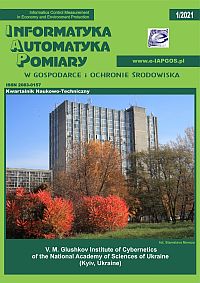POLYPARAMETRIC BLOCK CODING
Article Sidebar
Open full text
Issue Vol. 11 No. 1 (2021)
-
THE SYSTEM FOR COMPLEX MAGNETIC SUSCEPTIBILITY MEASUREMENT OF NANOPARTICLES WITH 3D PRINTED CARCASS FOR INTEGRATED RECEIVE COILS
Mateusz Midura, Przemysław Wróblewski, Damian Wanta, Grzegorz Domański, Mateusz Stosio, Jacek Kryszyn, Waldemar T. Smolik4-9
-
MAGNETOELECTRIC COUPLING MEASUREMENT TECHNIQUES IN MULTIFERROIC MATERIALS
Jakub Grotel10-14
-
METHODS FOR DETECTING FIRES IN ECOSYSTEMS USING LOW-RESOLUTION SPACE IMAGES
Valerii Shvaiko, Olena Bandurka, Vadym Shpuryk, Yevhen V. Havrylko15-19
-
GENERATING FIRE-PROOF CURTAINS BY EXPLOSION-PRODUCTION OF WATER AEROSOL AS AN ELEMENT OF FIRE-SAFETY ENGINEERING
Grzegorz Śmigielski20-23
-
METHODS FOR ASSESSMENT AND FORECASTING OF ELECTROMAGNETIC RADIATION LEVELS IN URBAN ENVIRONMENTS
Denys Bakhtiiarov, Oleksandr Lavrynenko, Nataliia Lishchynovska, Ivan Basiuk, Tetiana Prykhodko24-27
-
METHOD FOR DETERMINING THE ACTUAL PRESSURE VALUE IN A MV VACUUM INTERRUPTER
Michał Lech, Damian Kostyła28-31
-
OVERVIEW OF FEATURE SELECTION METHODS USED IN MALIGNANT MELANOMA DIAGNOSTICS
Magdalena Michalska32-35
-
DEVELOPING SOLUTION FOR USING ARTIFICIAL INTELLIGENCE TO OBTAIN MORE ACCURATE RESULTS OF THE BASIC PARAMETERS OF RADIO SIGNAL PROPAGATION
Andrii Shchepak, Volodimir Parkhomenko, Vyacheslav Parkhomenko36-39
-
APPLICATION OF THE MATRIX FACTOR ANALYSIS METHOD FOR DETERMINING PARAMETERS OF THE OBJECTIVE FUNCTION FOR TRANSPORT RISK MINIMIZATION
Serhii Zabolotnii, Sergii Mogilei40-43
-
DESCRIPTION OF ALGORITHMS FOR BALANCING NUMERICAL MATRICES AND THEIR DIVISION INTO HIERARCHICAL LEVELS ACCORDING TO THEIR TYPE AND COMPLEXITY
Yuriy Khanas, Michał Borecki44-49
-
POLYPARAMETRIC BLOCK CODING
Julia Milova, Yuri Melnik50-53
-
NO-CODE APPLICATION DEVELOPMENT ON THE EXAMPLE OF LOGOTEC APP STUDIO PLATFORM
Monika Moskal54-57
-
THE TRAINING APPLICATION BASED ON VR INTERACTION SCENARIOS – WITH EXAMPLES FOR LOGISTICS
Wojciech Wlodyka, Dariusz Bober58-61
-
INVESTIGATION OF THE DEPENDENCE OF THE STRUCTURE OF SHIFT INDEXES VECTORS ON THE PROPERTIES OF RING CODES IN THE MOBILE NETWORKS OF THE INTERNET OF THINGS
Vladislav Kravchenko, Olena Hryshchenko, Viktoriia Skrypnik, Hanna Dudarieva62-64
Archives
-
Vol. 13 No. 4
2023-12-20 24
-
Vol. 13 No. 3
2023-09-30 25
-
Vol. 13 No. 2
2023-06-30 14
-
Vol. 13 No. 1
2023-03-31 12
-
Vol. 12 No. 4
2022-12-30 16
-
Vol. 12 No. 3
2022-09-30 15
-
Vol. 12 No. 2
2022-06-30 16
-
Vol. 12 No. 1
2022-03-31 9
-
Vol. 11 No. 4
2021-12-20 15
-
Vol. 11 No. 3
2021-09-30 10
-
Vol. 11 No. 2
2021-06-30 11
-
Vol. 11 No. 1
2021-03-31 14
-
Vol. 10 No. 4
2020-12-20 16
-
Vol. 10 No. 3
2020-09-30 22
-
Vol. 10 No. 2
2020-06-30 16
-
Vol. 10 No. 1
2020-03-30 19
-
Vol. 9 No. 4
2019-12-16 20
-
Vol. 9 No. 3
2019-09-26 20
-
Vol. 9 No. 2
2019-06-21 16
-
Vol. 9 No. 1
2019-03-03 13
Main Article Content
DOI
Authors
Abstract
The principles of poly-parametric information coding have been considered. The methods for developing poly-parametric codes have been presented. It is shown that the protection of block codes from channel interference using check patterns can be developed by a mono- or poly-parametric method. A special type of block codes has been presented, the check patterns of which are formed on the basis of their neighbours, which are functionally related to the given code combination. Such codes have been called poly-parametric. Binary poly-parametric ring codes, the check patterns of which are designed to detect and correct channel errors, are developed using the properties of Galois fields and on the basis of the vector shift indicators of the codewords. To obtain digital poly-parametric block codes, the properties and features of the normalized natural sequence are used. It is shown that each codeword of a binary block code can be represented as a certain positive integer in the decimal number system, which is an element of the natural sequence. Its elements on an interval that equals the norm acquire a functional dependency.
Keywords:
References
Arora S., Barak B.: Computational Complexity: A Modern Approach. Cambridge University Press, Cambridge 2009. DOI: https://doi.org/10.1017/CBO9780511804090
Berlekamp E.: Algebraic coding theory. Mir, Moscow 1971. DOI: https://doi.org/10.1007/978-3-7091-4325-4
Blahut R. E.: Algebraic Codes for Data Transmission. Cambridge University Press, 2012.
Bronshtein I. N., Semendyaev K. A.: Mathematics reference book for engineers and students of technical colleges. GITTL, Moscow 1957.
Brouwer E., Shearer J. B., Sloane N. J. A., Smith W. D.: A new table of constant weight codes. IEEE Trans. Inform. Theory 36/1990, 1334–1380. DOI: https://doi.org/10.1109/18.59932
Carrasco R. A., Johnston M.: Non-binary error control coding for wireless communication and data storage. J. Wiley & Sons, 2008. DOI: https://doi.org/10.1002/9780470740415
Conway J. H., Sloane N. J. A.: Lexicographic codes: error-correcting codes from game theory. IEEE Trans. Inform. Theory 32/1986, 337–348. DOI: https://doi.org/10.1109/TIT.1986.1057187
Dikarev A. V.: Codes based on binary rings. Control systems, navigation and communication 1(29)/2014. 50–53.
Etzion T.: Optimal constant weight codes over Zk. and generalized designs. Discrete Math. 169/1997, 55–82. DOI: https://doi.org/10.1016/0012-365X(95)00333-R
MacKay D., Neal R.: Near Shannon limit performance of low density parity check codes. IEEE Electronics Letters 32(18)/1996, 1645–1646. DOI: https://doi.org/10.1049/el:19961141
Milova J. A.: Parameters of total codes. Zvyazok 4/2018, 3–32.
Milova Y.: Rationed natural row. Polyparametric coding. The European Journal of Technical and Natural Sciences 3/2020, 19–23 [http://doi.org/10.5604/20830157.1121333]. DOI: https://doi.org/10.5604/20830157.1121333
Milova J. A. et al.: Total codes. Zvyazok 3/2018, 47–50.
Robinson J. P., Bernstein A. J.: A class of binary recurrent codes with limited error propagation. EEE Transactions on Information Theory 13(1)/1967, 106–113 [http://doi.org/10.1109/TIT.1967.1053951]. DOI: https://doi.org/10.1109/TIT.1967.1053951
Article Details
Abstract views: 360
License

This work is licensed under a Creative Commons Attribution-ShareAlike 4.0 International License.






